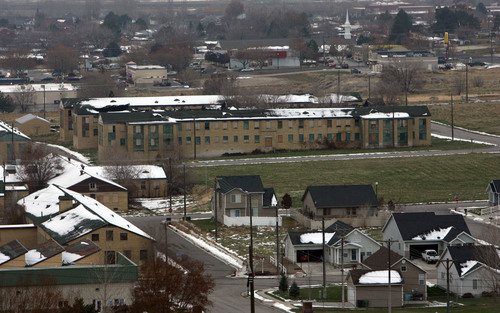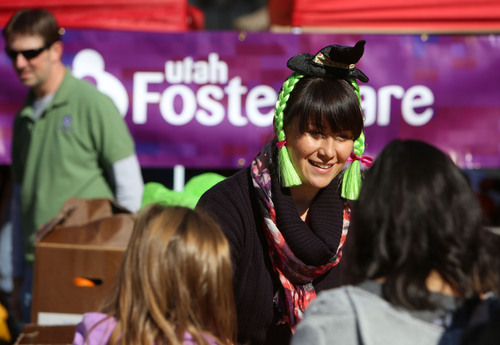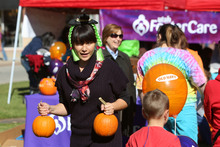This is an archived article that was published on sltrib.com in 2013, and information in the article may be outdated. It is provided only for personal research purposes and may not be reprinted.
Brandi Sweet is a member of the Turtle Mountain Band of Chippewa Indians of North Dakota, but that heritage is only partly why she is a perfect fit for the newly created post of American-Indian foster family recruiter at Utah Foster Care.
Sweet knows what it is like to be a child in foster care. She was one.
"I was a bad child," Sweet said. "It wasn't because of abuse and neglect. I was in trouble with the law. My mom didn't know what to do with me, which happens a lot of times with a lot of families when they have kids who are just kind of out of control."
Her story is hardly unusual: Extreme poverty led to homelessness, which led to substance abuse, then crime.
At age 15, Sweet landed in Montana's juvenile-detention system. For two years, Sweet moved between 10 different custodial placements. Not one, despite the effort of her relatives, was with a foster family who shared Sweet's cultural background.
"My family was telling them 'We are Native American, we are Native American' and nobody was listening to us at all," Sweet said. "They ended up transferring me 10 hours away from my family. ... The goal of this whole system is family reunification and strengthening, and then you're taking a child whose family can't afford to travel 10 hours [to see] them."
It didn't make sense to Sweet then, and it doesn't now — which has helped propel her along a career path that has focused on making a difference in the lives of tribal members.
Sweet, who moved to Utah about a year ago with her husband, previously worked in Washington, D.C., on numerous projects and initiatives involving American-Indian affairs with the White House and bureaus of Indian Education and Indian Affairs. She launched a consulting business a year ago and has worked with the Consolidated Tribes of the Goshute Reservation, Skull Valley Band of Goshute, Duckwater Shoshone and Ely Shoshone, among others.
Sweet said her new post, which is part time, will give her the opportunity to bring together all these personal and professional experiences to benefit her community. But Sweet, 31, knows she faces a huge challenge.
Currently, there are 13 licensed American-Indian foster families in Utah, well under the number needed, given the 124 children — including about 83 along the Wasatch Front — in state custody. Another 41 children are in custody of the Ute tribe, which is believed to have the most established social-services program of the state's eight federally recognized tribes, according to Mike Hamblin, recruitment director at Utah Foster Care.
Obstacles to recruiting more families include a hard-to-shake view of the U.S. government and its past efforts to "help" American Indians that began with initially locating Indian Affairs within the U.S. Department of War.
"There have been a lot of policies that the government has enacted that have been detrimental to Indian communities, Indian families, and Indian children in particular," Sweet said. "A lot of those policies related to termination and assimilation to remove [Indian] culture from families and communities, to take that Native identity away from the children and the families."
That effort was spurred in the late 1800s and early 1900s by boarding schools set up to educate and assimilate American-Indian children. It was general practice for children to have their hair cut, be dressed in uniforms and receive Christian names. They were prohibited from speaking their native languages.
In Utah, a former Army hospital in Brigham City became the home of the Intermountain Indian School, which operated from 1950 to 1984. Assimilation efforts in Utah also were driven by the Indian Placement Program operated by The Church of Jesus Christ of Latter-day Saints from 1947 to 1996, which led to thousands of American-Indian children being placed in Mormon homes.
The boarding-school phenomenon largely wiped out the traditional, shared approach to child rearing common in American-Indian communities.
"From the perspective of those who have been through it, they feel in many ways that has led to many of the problems the population now experiences," Hamblin said. "We're talking about as little as two generations ago, these people had no real experience or knowledge or opportunity to understand what it's like to be a part of a family and how a family is supposed to operate."
Hamblin said some issues arise "because the parents don't have parenting skills because they weren't parented and they've never seen what being a parent looks like. No one has ever modeled that for them, so they struggle to be a parent themselves."
The boarding-school movement also influenced child-welfare practices involving American Indians, Sweet said. The high removal rate of American-Indian children from their homes and communities led Congress to authorize the Indian Child Welfare Act (ICWA) in 1978.
Before the act, American-Indian children in Utah were 1,500 times more likely to be in foster care than other children in the state.
The act requires child-welfare agencies to follow certain steps when an American-Indian child — one who is either a member of an Indian tribe or is eligible for membership in a tribe as the child of a member — is placed in state custody. Those steps included notifying and allowing intervention of the appropriate tribe in a custody proceeding and giving placement preference to extended family, other tribe members or American-Indian families generally.
But as Sweet's experience and Utah data show, reaching the act's ideals is difficult.
"There is a huge amount of mistrust," Sweet said. "Foster care has typically come from state agencies that are seen as those that come in and take Native kids away. It's been a huge challenge."
American-Indian children in Utah are still four times more likely than other children to be in foster care, which some attribute to cultural differences in views of appropriate living conditions.
Between July 1, 2008, and June 25, 2013, the state placed 598 American-Indian children in foster care — 5 percent of the total number of children in foster care during that five-year period. Of the American-Indian children in foster care, 82 were eventually adopted.
Families that consisted of at least one American-Indian parent adopted 22 children, while 60 were placed with non-American-Indian parents, according to data from the Division of Child and Family Services.
While government mistrust persists, cultural norms and licensing requirements for foster families create other barriers that limit the number of American-Indian families stepping up to offer foster homes, Sweet said.
For example, multi-generational and doubled-up households are common in the American-Indian community. That can make it hard to meet such requirements as providing a child with a bedroom with least 80 square feet, or 60 square feet if the room is shared. Also, poverty remains high even among American Indians who no longer live on a reservation, Sweet said, which makes it difficult to cover other costs associated with providing foster care.
The state Office of Licensing, which certifies foster families, is revising requirements; some changes may lower some of these hurdles, Hamblin said.
Sweet believes it helps that Utah Foster Care is a partner with, but not part of, the state's child-welfare system.
"That creates a different kind of feeling and relationship and tone," she said.
Sweet also believes networking with the state's American-Indian tribes and asking families to step up will do more to provide or help find homes for children in need.
"We are going back to our community approach and our community responsibility," Sweet said, "that whole idea that it takes a community to raise a child, and asking every Native person that lives here in Utah and along the Wasatch Front to look deep down inside themselves and just see how they can support this effort."
So far, that outreach has been well received.
"I am seeing so much excitement that there is finally somebody doing this work," she said. "Everyone has known there was a huge need for this. There is almost a sense of relief."
Twitter: @Brooke4Trib —
Learn more about becoming a foster family
Brandi Sweet, the first American Indian foster family recruiter for Utah Foster Care, will share information about the program at the following events:
• Powwow Contest, Student Center Grand Ballroom, Utah Valley University, 800 W. University Parkway, Orem, Nov. 15-16, Friday at 6 p.m. and Saturday at noon.
• Indigenous Day, sponsored by the Utah Division of Indian Affairs, Taylorsville High School, 5225 S. Redwood Road, Taylorsville, Nov. 25, 6 p.m. Free. Information: amandarock@utah.gov
For information about becoming an American Indian foster family, visit http://www.utahfostercare.org/tribes.







